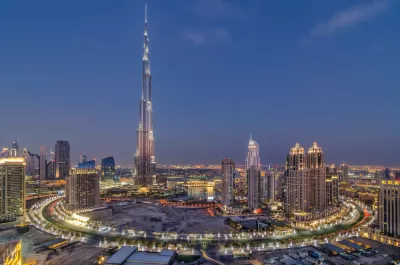A New York magazine article examines the idea of the mile-high skyscraper. Once imagined by Frank Lloyd Wright but impossible to build, the idea is not science fiction anymore.

Justin Davidson writes an in-depth article about the current limits of skyscraper technology and what it will take for the world's tallest towers to double in height and break the mile-high barrier.
Here Davidson introduces the idea of a mile-high skyscraper as impossible in the past and infeasible in the present:
"The mile-high skyscraper makes a little more sense to build now than it did when Frank Lloyd Wright designed one nearly 60 years ago. Wright imagined, on the fringes of Chicago, a habitable 528-story sundial called the Illinois. That idea wasn’t buildable then; its successor would still be risky, financially ruinous, slow to construct, and inefficient to operate. But that doesn’t mean a mile-high skyscraper won’t get done."
A common undercurrent of the article is an inherent warning: "A mile’s not science fiction. It’s not even an outer limit." But, writes Davidson, sometimes limits are a good thing: "Technological capacities have outpaced our judgment. We know we can do it, but we don’t know when not to do it."
The article includes technical detail about what makes the world's tallest buildings possible and some speculation about the challenges that the next generation of tallest towers will have to overcome in achieving new heights. Davidson also ties the conversation back to New York City—a place unlikely to ever have the "tallest anything" ever again but still not immune to the impacts of the skyward expansion of building technology.
FULL STORY: The Rise of the Mile-High Building

Maui's Vacation Rental Debate Turns Ugly
Verbal attacks, misinformation campaigns and fistfights plague a high-stakes debate to convert thousands of vacation rentals into long-term housing.

Planetizen Federal Action Tracker
A weekly monitor of how Trump’s orders and actions are impacting planners and planning in America.

Chicago’s Ghost Rails
Just beneath the surface of the modern city lie the remnants of its expansive early 20th-century streetcar system.

Bend, Oregon Zoning Reforms Prioritize Small-Scale Housing
The city altered its zoning code to allow multi-family housing and eliminated parking mandates citywide.

Amtrak Cutting Jobs, Funding to High-Speed Rail
The agency plans to cut 10 percent of its workforce and has confirmed it will not fund new high-speed rail projects.

LA Denies Basic Services to Unhoused Residents
The city has repeatedly failed to respond to requests for trash pickup at encampment sites, and eliminated a program that provided mobile showers and toilets.
Urban Design for Planners 1: Software Tools
This six-course series explores essential urban design concepts using open source software and equips planners with the tools they need to participate fully in the urban design process.
Planning for Universal Design
Learn the tools for implementing Universal Design in planning regulations.
planning NEXT
Appalachian Highlands Housing Partners
Mpact (founded as Rail~Volution)
City of Camden Redevelopment Agency
City of Astoria
City of Portland
City of Laramie


























